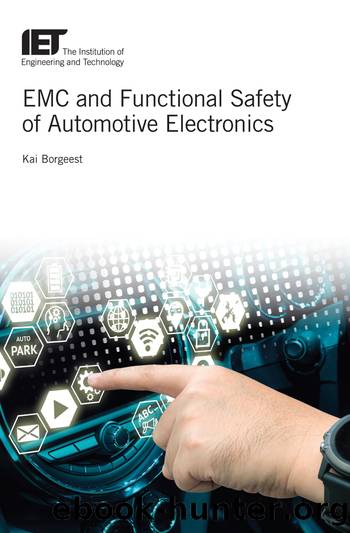EMC and Functional Safety of Automotive Electronics by Kai Borgeest;

Author:Kai Borgeest; [Неизв.]
Language: eng
Format: epub
ISBN: 9781785614088
Publisher: Institution of Engineering & Technology
Published: 2018-06-21T21:00:00+00:00
Figure 4.8 Principal idea of the transfer impedance
4.5 Sources
One common criterion to categorise sources of EMI is to distinguish between intentional sources (wireless signal transmitters) and unintentional sources. Although their physical effect is the same, problems with unintentional sources can be solved at the source, the coupling path or the sink, whereas intentional sources (and unintentional sources outside the car) usually cannot be modified, so only the coupling path and the sink can be considered for solution. Intentional sources must be distinguished from intentional electromagnetic interference (IEMI), where EMI is not a side effect of an intentional use, but the desired principal effect for criminal or military purposes. During design, most unintentional sources can be identified easily where high current or voltages are switched quickly or high-frequency signals are processed. On the other hand, in practice, if problems occur, the search for sources in an unknown environment can be very laborious.
Another criterion is the kind of signal. It can be continuous or transient. Continuous signals can carry a digital, analogue or no modulation.
A further criterion is the frequency. Table 4.2 lists some typical sources. For narrow-band sources (very often intended sources), the frequency range is given, and for broadband sources the spectrum may reach to infinite and it is not reasonable to give a limit.
The radiation intensity of a source can be given as a power or a field strength. Sometimes the effective isotropically radiated power (EIRP) is given. The power P fed into an isotropic radiator distributes in all directions with the same intensity. So the power density Sm at a given distance r from the radiator is the power divided by the surface area of a sphere with radius r.
Table 4.2 Interference sources. n is the revolution speed of the generator and p, the number of pole pairs. There are non-public GSM applications with frequencies below 850 MHz. Amateur radio uses many different bands with different modulations; in a vehicle operation, the 2-m or 77-cm bands are most likely, other bands have been omitted. For poor channel quality, LTE falls back from QAM to QPSK
Download
This site does not store any files on its server. We only index and link to content provided by other sites. Please contact the content providers to delete copyright contents if any and email us, we'll remove relevant links or contents immediately.
| Automotive | Engineering |
| Transportation |
Whiskies Galore by Ian Buxton(41788)
Introduction to Aircraft Design (Cambridge Aerospace Series) by John P. Fielding(33041)
Small Unmanned Fixed-wing Aircraft Design by Andrew J. Keane Andras Sobester James P. Scanlan & András Sóbester & James P. Scanlan(32726)
Craft Beer for the Homebrewer by Michael Agnew(18119)
Turbulence by E. J. Noyes(7918)
The Complete Stick Figure Physics Tutorials by Allen Sarah(7289)
Kaplan MCAT General Chemistry Review by Kaplan(6849)
The Thirst by Nesbo Jo(6801)
Bad Blood by John Carreyrou(6515)
Modelling of Convective Heat and Mass Transfer in Rotating Flows by Igor V. Shevchuk(6375)
Learning SQL by Alan Beaulieu(6190)
Weapons of Math Destruction by Cathy O'Neil(6115)
Man-made Catastrophes and Risk Information Concealment by Dmitry Chernov & Didier Sornette(5897)
Digital Minimalism by Cal Newport;(5627)
Life 3.0: Being Human in the Age of Artificial Intelligence by Tegmark Max(5440)
iGen by Jean M. Twenge(5349)
Secrets of Antigravity Propulsion: Tesla, UFOs, and Classified Aerospace Technology by Ph.D. Paul A. Laviolette(5292)
Design of Trajectory Optimization Approach for Space Maneuver Vehicle Skip Entry Problems by Runqi Chai & Al Savvaris & Antonios Tsourdos & Senchun Chai(4992)
Electronic Devices & Circuits by Jacob Millman & Christos C. Halkias(4887)
